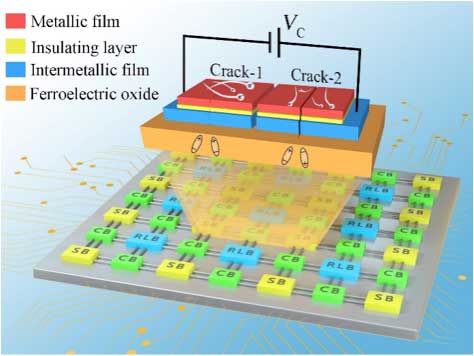| Jun 29, 2020 | |
Nanoelectromechanical switches based reconfigurable computing |
|
| (Nanowerk Spotlight) Reconfigurable computing (RC) can be specialized to a particular task through its universal programmability, offering large flexibility and short time from design to realization. Yet, conventional RC based on complementary metal oxide semiconductor (CMOS) technology has some limitations, such as low speed, high energy consumption and large chip area. Therefore, considerable effort has been devoted to beyond-CMOS devices, such as nanoelectromechanical (NEM) switches and ferroelectric device. | |
| NEM switches have created exciting opportunities for energy-efficient electronic devices owing to the quasi-zero leakage current, ultra-high ON/OFF ratio, and abrupt switching behavior. However, electrostatically actuated NEM switches usually rely on a cantilever or suspended nanostructure, which is implemented through an involved fabrication process. A complementary structure is even more difficult. | |
| On the other hand, ferroelectric devices, which generally exploit ferroelectric polarization switching, feature nonvolatility, high speed and low energy, but a non-destructive readout process is highly desirable. | |
| Recently, a research team from Huazhong University of Science and Technology in China, realized a very simple NEM switch by exploiting a switchable ferroelectric nanocrack controlled by an out-of-plane voltage in a metallic alloy/ferroelectric heterostructure. The crack is formed in a controllable manner in terms of its initiation, location, and orientation through a bridge-like structure. The open and closed states of the crack are actuated by ferroelectric polarization switching under the out-of-plane voltage. | |
| Thus, this simple ferroelectric-nanocrack based NEM switch can integrate the advantages of both ferroelectric and NEM switches and presents a novel opportunity for nonvolatile energy-efficient memory and logic. | |
 |
|
| Reconfigurable computing based on ferroelectric crack-based complementary nanoelectromechanical switches. (Stock image). | |
| Furthermore, the researchers have presented a novel two-crack based complementary nanoelectromechanical (CNEM) switch by applying a low in-plane voltage onto two separate intermetallic electrodes. | |
| They exploited this ferroelectric crack-based CNEM switch to construct energy-efficient and high-density RC. | |
| This work was reported in the journal IEEE Electron Device Letters recently and featured as “Editors’ Pick”. | |
| The crack-based CNEM switch cell consists of two parts: 1) switchable cracks induced by ferroelectric domain switching, and 2) the current path in top metallic films controlled by the states of extended cracks. In this case, the writing operation is implemented by applying the control voltage onto the ferroelectric oxide. | |
| Specifically, one of the two cracks (crack-1 or crack-2) is always in OFF state and the other is ON. The polarity of voltage determines these states. The readout operation is performed by detecting the states of cracks using a small constant voltage, thus achieving a non-destructive process. | |
| Complementary switching enables this device to operate as a CMOS inverter in a very simple manner. This property can be employed to construct the programmable routings and logic blocks of RC. Low dynamic and static power consumption can be obtained owing to the low ON-resistance and quasi-zero OFF-state leakage current. The voltage required to maintain the routings is not needed, leading to a significant saving in static power consumption. | |
| In addition, the fundamental AND, OR and NOT logic gates can be integrated into a single CNEM switch device, thereby reducing chip area and energy dissipation. | |
| “In future studies, we plan to verify the ability to scale the device down, along with improving the endurance of crack switching,” says Professor Long You, who led the research at Huazhong University of Science and Technology. “Ultimately, we hope to be able to commercialize this new technology.” | |
Journal References |
|
| 1. Qiang Luo, Zhe Guo, Houbing Huang, Qiming Zou, Xiangwei Jiang, Shuai Zhang, Hongjuan Wang, Min Song, Bao Zhang, Hong Chen, Haoshuang Gu, Genquan Han, Xiaofei Yang, Xuecheng Zou, Kai-You Wang, Zhiqi Liu, Jeongmin Hong, Ramamoorthy Ramesh and Long You. Nanoelectromechanical switches by controlled switchable cracking. Nanoelectromechanical switches by controlled switchable cracking. IEEE Electron Device Letters, 2019, 40(7): 1209~1212. DOI: 10.1109/LED.2019.291792 | |
| 2. Qiang Luo, Zhe Guo, Shuai Zhang, Xiaofei Yang, Xuecheng Zou, Jenogmin Hong and Long You. Crack-based complementary nanoelectromechanical switches for reconfigurable computing. IEEE Electron Device Letters, 2020, 41(5): 784~787. DOI: 10.1109/LED.2020.298373 | |
|
Provided by Huazhong University of Science and Technology as a Nanowerk exclusive
|
|
|
Become a Spotlight guest author! Join our large and growing group of guest contributors. Have you just published a scientific paper or have other exciting developments to share with the nanotechnology community? Here is how to publish on nanowerk.com. |
|
